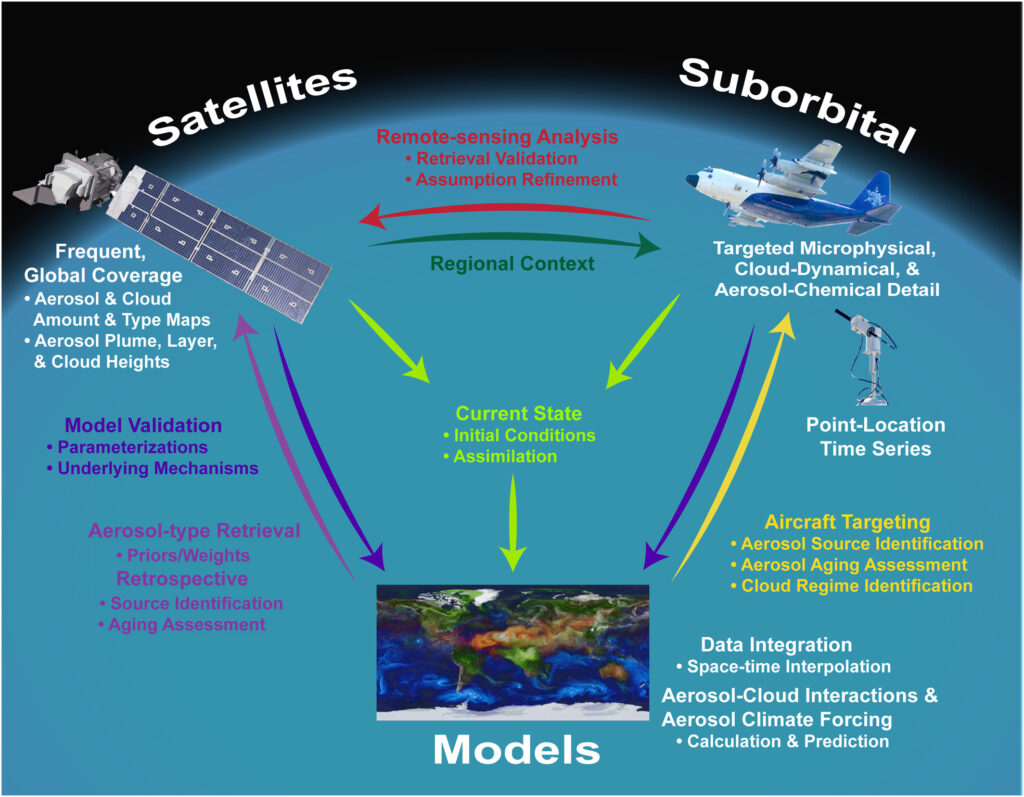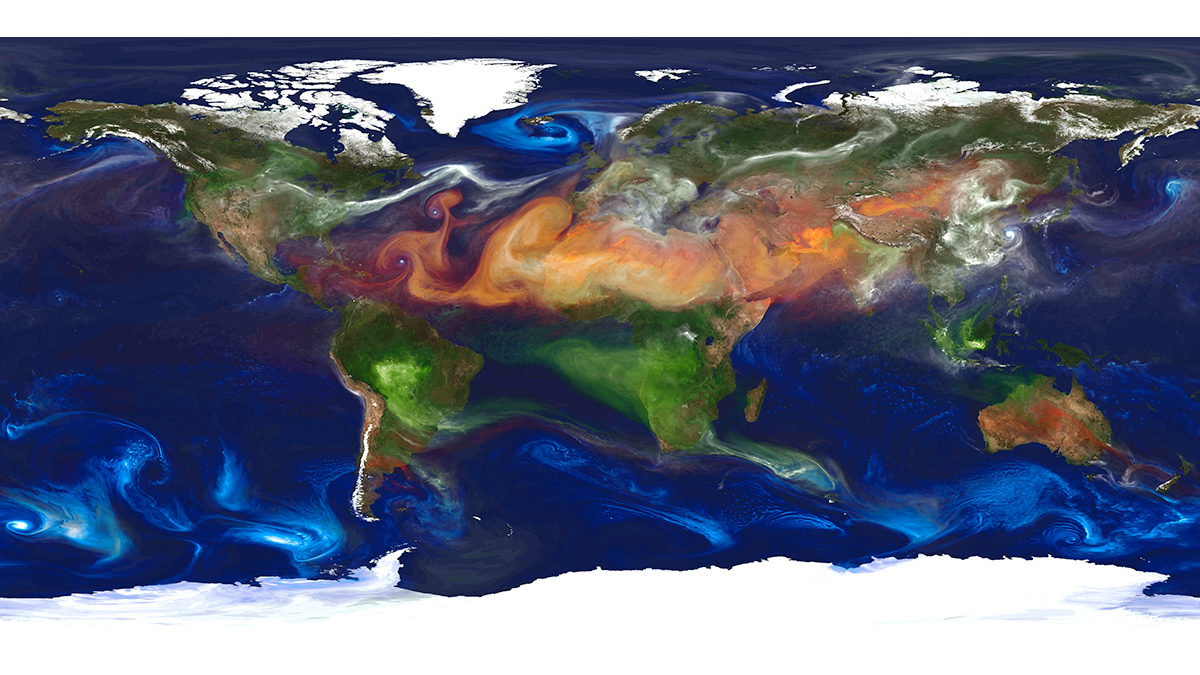Editors’ Vox is a blog from AGU’s Publications Department.
“Aerosol forcing” describes the contributions aerosol particles make toward heating and cooling the Earth system. This includes the direct effects they have by scattering and absorbing sunlight, as well as the indirect effects produced as aerosols alter the properties and distribution of clouds.
Most reviews of aerosol climate forcing adopt a model-centric perspective, as models offer the ability to make climate predictions. A recent study in Reviews of Geophysics takes a more measurement-oriented perspective, making it possible to identify observational gaps that need to be filled. We asked the lead author to give an overview of aerosols, why uncertainty in aerosol climate forcing exists, and what additional efforts are needed.
In simple terms for a non-scientist, what are aerosols and how do they affect Earth’s climate and atmosphere?
“Aerosols” are airborne particles. They can be wildfire smoke or desert dust particles, volcanic ash or sulfates, pollution particles generated by combustion or cement production, or biogenic particles, such as pollen or new particles that form from gases emitted by trees.
Most aerosol particles reflect sunlight, diminishing the amount of solar energy reaching Earth’s surface. Some particles are dark, meaning they also absorb sunlight, which can heat and stabilize the ambient atmosphere, evaporating nearby cloud droplets, suppressing convection, and even changing large-scale atmospheric circulations. Aerosols are also required in most circumstances to form cloud droplets, by serving as collection sites for water molecules.
Why is it difficult for scientists to quantify the impacts of aerosols compared to other climate forcings, such as greenhouse gases?
Aerosol particles exhibit an enormous range of physical, chemical, and optical properties due to the variety of source types and mechanisms that produce them.
Aerosol particles exhibit an enormous range of physical, chemical, and optical properties due to the variety of source types and mechanisms that produce them. Their properties can also change as a result of physical or chemical aging within the atmosphere. Most remain aloft for just a few days to a week so the diversity of particle properties does not have time to homogenize in the atmosphere. As such, the properties, amounts, and three-dimensional distributions of aerosol particles must be monitored frequently on a global basis.
Further, for most aerosol types, their detailed chemical and physical properties are not well characterized, such as their ability to adsorb water, the relationship between their mass and their light-extinction ability, and even their spectral light-absorption. Greenhouse gases (GHGs) have distinct, species-specific properties that are well known, they can be monitored precisely by remotely sensing their unique spectra, and the long-lived GHGs such as CO2 are distributed much more homogeneously within the atmosphere.
Why does so much uncertainty persist despite advances in aerosol-climate science?
This question gets at the heart of the “Three-Way Street”. Satellites and suborbital (i.e., aircraft + surface) measurements, as well as climate models, have a unique and essential role to play in constraining aerosol forcing of climate (see figure below). Although current and planned satellite and modeling efforts are adequate to meeting their respective roles in characterizing aerosol particles and effects, the suborbital component is at present severely lacking, both in terms of systematically determining the properties of the major aerosol air-mass types, globally, and in representing the mechanisms associated with aerosol-cloud interactions.
Further – and this is especially important – each of the three elements has critical contributions to make to the other two; this is the Three-Way Street, represented by the color-coded arrows and annotations in the figure below. To date, far too little research effort has focused on this integration of the three elements.

Why is it important to reduce uncertainty of aerosol climate forcing?
The magnitudes of aerosol direct and indirect climate forcing represent the largest uncertainties in models used to characterize the current state and to simulate future climate.
According to all the recent Intergovernmental Panel on Climate Change (IPCC) assessment reports, the magnitudes of aerosol direct and indirect climate forcing, and even the underlying mechanisms, represent the largest uncertainties in models used to characterize the current state and to simulate future climate. As such, reducing the uncertainty in aerosol-climate forcing is critical for any effort to attribute, mitigate, or predict climate changes.
What techniques or methods are currently used to measure and model aerosols?
There is a vast literature elaborating on this question. Very briefly, satellite instruments generally provide frequent, global coverage. Broad-swath, passive imagers can monitor the column-amount of airborne particles (usually represented as the mid-visible aerosol optical depth), and can provide, under favorable retrieval conditions, some qualitative information about aerosol “type,” which amounts to loose constraints on particle size, shape, and light-absorption properties. Obtaining particle property information from passive remote sensing depends upon having cameras with some combination of multi-spectral, multi-angle, and/or polarization sensitivity.
Active instruments, namely space-based lidars, can sweep out narrow curtains showing the vertical distribution of particle backscattering along an orbit track, and can also provide loose constraints on particle type from multi-spectral, polarization, and/or high-spectral-resolution measurements. Aircraft and surface-based instruments can offer similar remote-sensing capabilities, but can in addition collect samples in situ, which allows for much more detailed physical and chemical characterization; suborbital platforms can also sample on the spatial and temporal scales required to characterize aerosol-cloud interaction mechanisms.
Numerical models are essential for calculating direct and indirect aerosol forcing globally, for filling gaps in the observational record, and for making climate forcing and response predictions based on assumed future emissions scenarios.
What additional efforts are needed to gather data, increase our understanding of aerosols, and reduce uncertainty about their role in climate forcing?
I partly addressed this above, in answer to the question about why considerable aerosol-climate-forcing-uncertainty persists. More specifically, new efforts are needed: (1) to obtain aircraft in situ measurements that capture systematically aerosol particle properties for the major aerosol airmass types, globally, (2) to conceive, develop, and implement an aircraft and surface-based program aimed at filling gaps in our understanding of the interactions between aerosol particles and clouds, along with (3) focusing much more research on integrating the unique contributions of satellite observations, suborbital measurements, and modeling, to reduce the uncertainty in our understanding of Earth’s changing climate.
—Ralph A. Kahn ([email protected], ![]() 0000-0002-5234-6359), Earth Sciences Division, Goddard Space Flight Center, National Aeronautics and Space Administration, USA
0000-0002-5234-6359), Earth Sciences Division, Goddard Space Flight Center, National Aeronautics and Space Administration, USA
Editor’s Note: It is the policy of AGU Publications to invite the authors of articles published in Reviews of Geophysics to write a summary for Eos Editors’ Vox.

